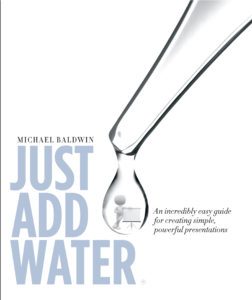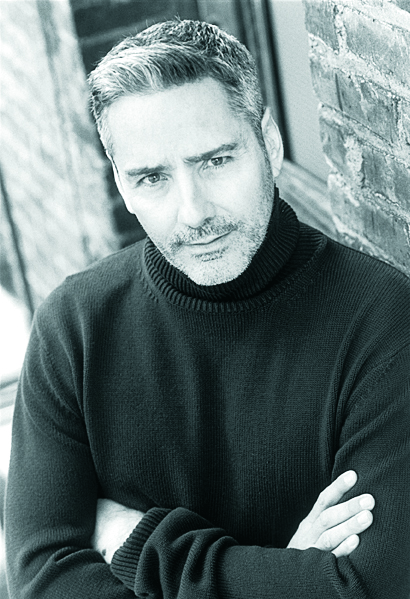Global Marketing Guru, Michael Baldwin’s New Book “Just Add Water” Explains in Simple terms the Art of Presentation
Michael Baldwin has been a leader in the communications industry for over 25 years. He has worked in Top 10 advertising agencies, has built global brands, has led global teams in solving complex strategic problems, and has even found himself working for Steve Jobs back in the days of neXT. His latest venture, Just Add Water, a book on the “Do’s” of Power Point, finds the author sharing his experience in the art of Presentation.
 Just Add Water, published by Inkshares, reads the way Mr. Baldwin’s presentations are, well, presented; in an enjoyable and streamlined fashion. Instead of being text heavy, Mr. Baldwin opts for the use of icons, metaphors, concepts, and a bit of humor. According to Mr. Baldwin, there is nothing hypothetical about Just Add Water. All of the information is a distillation of Baldwin’s years operating as a global presenter.
Just Add Water, published by Inkshares, reads the way Mr. Baldwin’s presentations are, well, presented; in an enjoyable and streamlined fashion. Instead of being text heavy, Mr. Baldwin opts for the use of icons, metaphors, concepts, and a bit of humor. According to Mr. Baldwin, there is nothing hypothetical about Just Add Water. All of the information is a distillation of Baldwin’s years operating as a global presenter.
Recently, Michael and I had a conversation regarding his book, branding, and lessons from Steve Jobs, as well as Baldwin’s thoughts on Detroit 2.0. Michael speaks quickly and confidently, has the ability to bounce from subject to subject, and just so happens to have a pleasant speaking voice.
_________________________________________
Interview
Anthony Brancaleone: Steve Jobs said, “Power Points are for those who don’t know what they’re talking about”. What are your thoughts?
Michael Baldwin: I know Jobs, worked for him, in fact. He was a genius. But, Power Point is not the problem, people not knowing how to use it is the problem. Used properly, it’s a whole different way of communicating.
AB: How should Power Point be used?
MB: Great presenters are able to communicate their ideas simply and powerfully. They are great storytellers, who know how to deliver their message in a seemingly effortless manner. Just Add Water is a GPS for anyone’s Power Point road trip.
AB: How were you able to distill years of experience into what is a fairly concise book on Presentation, and still manage to keep it interesting?
MB: I’m extremely right brain, extremely visual. Just Add Water is my first book, and for me it had to be absolutely visual. I wanted it to be the Joy of Cooking of presentation books. So, I used my day program, How To Put The Power Back In Power Point, as a guide and just tried to recreate the guide in writing the best I could.
“We are really trying to capture the compulsion of the business owner”
AB: You have been operating as a global brand strategist for much of your career; have worked with Ogilvy & Mather on a $500 million IBM account; have worked with Ammirati & Puris, BBDO, and have led campaigns for Apple, Compaq, and neXT, among others; Where do you begin when dealing with branding global companies?
MB: First of all, I love branding. For me, I start with the owner of the company. We explore the reasons the owner began in the first place. I find that’s the most authentic starting point. From there, we look for a creative use for the words that the owner has just used in describing her or his business. We are really trying to capture the compulsion of the business owner.
AB: Where are most of us falling short when we are attempting to brand our company?
MB: It’s actually an incredibly easy guide that I follow for creating names and brands and maintaining both. Branding is not a dark art for experts only. That idea is just ridiculous. I can usually do it with the founders of a company alone in a room in 3 minutes. The goal is always to capture the essence of the service or business. Apple is a 100% pharmaceutical experience, for example. 100%. It is concise, intuitive and streamlined. With start-ups, I usually have 4 meetings and then launch. I like to brand alone, as a consultant; the more people the more trouble.
“What’s more American than Detroit?”
AB: What are the essential components of a ‘brand’?
MB: A world-class logo would be the #1 criteria for a brand. It cannot separate the name from the logo itself. It must have the name of the product attached. Apple may be the exception, but that’s because the logo is an apple. For start-ups, if you use an external designer, the logo process can be tricky. Start-ups should deal with people who are not brand people dealing solely with objects. The name must be attached.
AB: What have been your challenges while creating the Michael Baldwin brand?
MB: I used my #1 rule: Capture everything. Then it’s a removal process of swatting away the noise.
AB: How should small businesses integrate print, radio, TV and social media when it comes to advertising and marketing their brand, or are those platforms foes?
MB: A company’s brand has to become an idea: Apple equals cool. Volvo equals safety. BMW equals performance – The Ultimate Driving Machine has lasted 40 years. (Martin Puris is responsible for that, by the way. Ammirati & Puris is the greatest agency in the history of advertising). All communication has to reinforce the idea behind the brand, and each platform has its own strengths. I’m a believer in all of them so long as they are properly utilized.
Having said that, I often say there is something anti-social about social media. I sometimes refer to it as ‘Socially Isolating Media’. Basically, it’s another way of saying, ‘mobile phone’. And, because of this we have all become targets for consumerism 24-7. Trying to navigate story on a phone can be irritating for the user. I’m not so sure how much of this noise will be with us in 4-5 years.
“There is something anti-social about social media”
AB: You worked with Steve Jobs at neXT – I was hoping you wouldn’t mind offering some insight on the man.
MB: Steve would pull from people what they didn’t know they had. He said, “simplicity is the process of elimination”. Steve believed in the removal of the extraneous. After Steve left Apple all of those losers came in and created boring products. When Steve came back he got rid of the imposters, he fired them all. He really did remind the world what can be done when you’re dedicated. Apple’s ‘Here’s To The Crazy One’s’ campaign said it all, really. Steve was genius. He never forgets and he never changes his mind, and because of it we have Apple. Tim Cook is an incredibly decent human being. But genius, or a visionary like Steve, he is not. But, then, who is?
AB: As you are aware, Detroit has been in the midst of a renaissance over the past few years. How would you go about branding the city?
MB: That is a brilliant question (Editor’s note: Michael didn’t actually say that, but I felt he may have been thinking it). Detroit strikes me as potentially one of the greatest 2.0 stories we’re going to have in America. It has the opportunity to re-imagine its infrastructure, its urban centers, and its work habits. I would start by asking, ‘what are the immovable objects?’. The name ‘Detroit’ is one. I would utilize some group thought from leaders in the community, and move to fuse words with Detroit. Cadillac did it! Use that as a guide.
AB: Yes, ‘Detroit’ would be one of those immovable objects. I suppose so too the words ‘auto’, ‘music’, and lately, ‘cocktails’, or ‘food’, or even ‘art’, as Detroit is certainly growing in each of those areas. But, you mentioned ‘infrastructure’; what are your thoughts there?
MB: How about becoming the first fiber optic city in America? There is no faster tech than light. Fiber optics could be used for all infrastructure; traffic lights, everything. I would call Sergey Brin or Larry Page at google and begin all of the preparatory. Detroit could be ‘Fiber Optic City’.
Find Just Add Water at Inkshares.com or visit Baldwin.com

